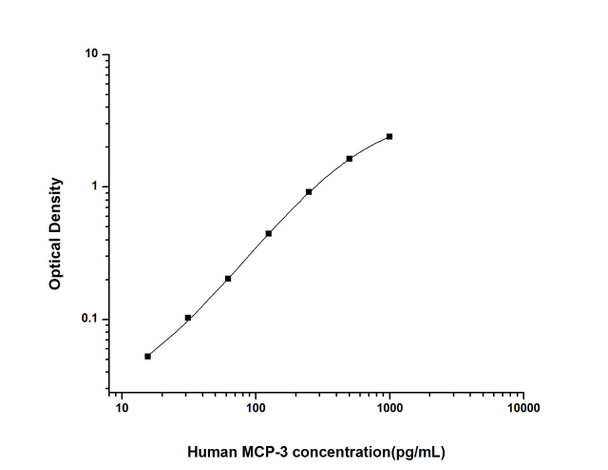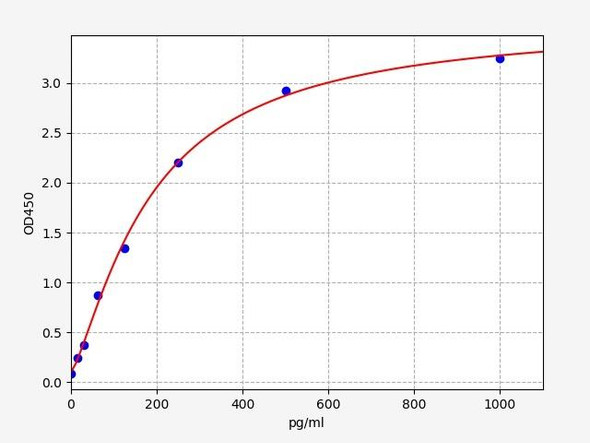Human MCP-3 (Monocyte Chemotactic Protein 3) ELISA Kit (HUES01311)
- SKU:
- HUES01311
- Product Type:
- ELISA Kit
- Size:
- 96 Assays
- Uniprot:
- P80098
- Sensitivity:
- 9.38pg/mL
- Range:
- 15.63-1000pg/mL
- ELISA Type:
- Sandwich
- Synonyms:
- MCP3, FIC, MARC, NC28, SCYA6, SCYA7
- Reactivity:
- Human
- Sample Type:
- Serum, plasma and other biological fluids
- Research Area:
- Cell Biology
Description
Human MCP-3 (Monocyte Chemotactic Protein 3) ELISA Kit
The Human MCP-3 (Monocyte Chemotactic Protein-3) ELISA Kit is specially designed for the precise measurement of MCP-3 levels in human serum, plasma, and cell culture supernatants. This kit offers superior sensitivity and specificity, ensuring accurate and consistent results for a variety of research purposes.MCP-3 is a key chemokine involved in the recruitment of monocytes to sites of inflammation, playing a crucial role in immune response regulation. Dysregulation of MCP-3 has been linked to various inflammatory conditions, autoimmune diseases, and cancer progression, making it a valuable biomarker for investigating these diseases and potential therapeutic interventions.
With its advanced technology and reliable performance, the Human MCP-3 ELISA Kit is an indispensable tool for researchers seeking to study the role of MCP-3 in health and disease, ultimately advancing our understanding and treatment of inflammatory disorders.
| Assay type: | Sandwich |
| Format: | 96T |
| Assay time: | 4.5h |
| Reactivity: | Human |
| Detection Method: | Colormetric |
| Detection Range: | 15.63-1000 pg/mL |
| Sensitivity: | 9.38 pg/mL |
| Sample Volume Required Per Well: | 100µL |
| Sample Type: | Serum, plasma and other biological fluids |
| Specificity: | This kit recognizes Human MCP-3 in samples. No significant cross-reactivity or interference between Human MCP-3 and analogues was observed. |
This ELISA kit uses Sandwich-ELISA as the method. The micro ELISA plate provided in this kit has been pre-coated with an antibody specific to Human MCP-3. Standards or samples are added to the appropriate micro ELISA plate wells and combined with the specific antibody. Then a biotinylated detection antibody specific for Human MCP-3 and Avidin-Horseradish Peroxidase (HRP) conjugate are added to each micro plate well successively and incubated. Free components are washed away. The substrate solution is added to each well. Only those wells that contain Human MCP-3, biotinylated detection antibody and Avidin-HRP conjugate will appear blue in color. The enzyme-substrate reaction is terminated by adding Stop Solution and the color turns yellow. The optical density (OD) is measured spectrophotometrically at a wavelength of 450 nm ± 2 nm. The OD value is proportional to the concentration of Human MCP-3. The concentration of Human MCP-3 in samples can be calculated by comparing the OD of the samples to the standard curve.
| UniProt Protein Function: | CCL7: Chemotactic factor that attracts monocytes and eosinophils, but not neutrophils. Augments monocyte anti-tumor activity. Also induces the release of gelatinase B. This protein can bind heparin. Binds to CCR1, CCR2 and CCR3. Belongs to the intercrine beta (chemokine CC) family. |
| UniProt Protein Details: | Protein type:Secreted; Motility/polarity/chemotaxis; Secreted, signal peptide Chromosomal Location of Human Ortholog: 17q11. 2-q12 Cellular Component: extracellular space; extracellular region Molecular Function:heparin binding; CCR1 chemokine receptor binding; CCR2 chemokine receptor binding; chemokine activity Biological Process: cellular calcium ion homeostasis; regulation of cell shape; monocyte chemotaxis; cell-cell signaling; eosinophil chemotaxis; response to gamma radiation; cytoskeleton organization and biogenesis; immune response; chemotaxis; inflammatory response; signal transduction; positive regulation of cell migration |
| NCBI Summary: | This gene encodes monocyte chemotactic protein 3, a secreted chemokine which attracts macrophages during inflammation and metastasis. It is a member of the C-C subfamily of chemokines which are characterized by having two adjacent cysteine residues. The protein is an in vivo substrate of matrix metalloproteinase 2, an enzyme which degrades components of the extracellular matrix. This gene is part of a cluster of C-C chemokine family members on chromosome 17q. [provided by RefSeq, Jul 2008] |
| UniProt Code: | P80098 |
| NCBI GenInfo Identifier: | 1170890 |
| NCBI Gene ID: | 6354 |
| NCBI Accession: | P80098. 3 |
| UniProt Secondary Accession: | P80098,Q569J6, |
| UniProt Related Accession: | P80098 |
| Molecular Weight: | 11,200 Da |
| NCBI Full Name: | C-C motif chemokine 7 |
| NCBI Synonym Full Names: | chemokine (C-C motif) ligand 7 |
| NCBI Official Symbol: | CCL7 |
| NCBI Official Synonym Symbols: | FIC; MARC; MCP3; NC28; MCP-3; SCYA6; SCYA7 |
| NCBI Protein Information: | C-C motif chemokine 7; small-inducible cytokine A7; monocyte chemotactic protein 3; monocyte chemoattractant protein 3; small inducible cytokine A7 (monocyte chemotactic protein 3) |
| UniProt Protein Name: | C-C motif chemokine 7 |
| UniProt Synonym Protein Names: | Monocyte chemoattractant protein 3; Monocyte chemotactic protein 3; MCP-3; NC28; Small-inducible cytokine A7 |
| Protein Family: | C-C motif chemokine |
| UniProt Gene Name: | CCL7 |
| UniProt Entry Name: | CCL7_HUMAN |
As the OD values of the standard curve may vary according to the conditions of the actual assay performance (e. g. operator, pipetting technique, washing technique or temperature effects), the operator should establish a standard curve for each test. Typical standard curve and data is provided below for reference only.
| Concentration (pg/mL) | O.D | Average | Corrected |
| 1000 | 2.441 2.467 | 2.454 | 2.397 |
| 500 | 1.674 1.69 | 1.682 | 1.625 |
| 250 | 0.981 0.961 | 0.971 | 0.914 |
| 125 | 0.48 0.52 | 0.5 | 0.443 |
| 62.5 | 0.27 0.25 | 0.26 | 0.203 |
| 31.25 | 0.17 0.148 | 0.159 | 0.102 |
| 15.63 | 0.106 0.112 | 0.109 | 0.052 |
| 0 | 0.057 0.057 | 0.057 | -- |
Precision
Intra-assay Precision (Precision within an assay): 3 samples with low, mid range and high level Human MCP-3 were tested 20 times on one plate, respectively.
Inter-assay Precision (Precision between assays): 3 samples with low, mid range and high level Human MCP-3 were tested on 3 different plates, 20 replicates in each plate.
| Intra-assay Precision | Inter-assay Precision | |||||
| Sample | 1 | 2 | 3 | 1 | 2 | 3 |
| n | 20 | 20 | 20 | 20 | 20 | 20 |
| Mean (pg/mL) | 52.55 | 124.50 | 445.48 | 55.33 | 117.65 | 477.94 |
| Standard deviation | 2.64 | 7.22 | 19.07 | 3.36 | 6.21 | 20.26 |
| C V (%) | 5.02 | 5.80 | 4.28 | 6.07 | 5.28 | 4.24 |
Recovery
The recovery of Human MCP-3 spiked at three different levels in samples throughout the range of the assay was evaluated in various matrices.
| Sample Type | Range (%) | Average Recovery (%) |
| Serum (n=5) | 89-103 | 95 |
| EDTA plasma (n=5) | 93-106 | 99 |
| Cell culture media (n=5) | 96-107 | 102 |
Linearity
Samples were spiked with high concentrations of Human MCP-3 and diluted with Reference Standard & Sample Diluent to produce samples with values within the range of the assay.
| Serum (n=5) | EDTA plasma (n=5) | Cell culture media (n=5) | ||
| 1:2 | Range (%) | 87-101 | 88-99 | 85-98 |
| Average (%) | 92 | 93 | 91 | |
| 1:4 | Range (%) | 90-105 | 81-96 | 83-96 |
| Average (%) | 96 | 88 | 90 | |
| 1:8 | Range (%) | 88-101 | 82-96 | 83-98 |
| Average (%) | 94 | 88 | 89 | |
| 1:16 | Range (%) | 92-104 | 83-93 | 87-100 |
| Average (%) | 97 | 88 | 93 |
An unopened kit can be stored at 4°C for 1 month. If the kit is not used within 1 month, store the items separately according to the following conditions once the kit is received.
| Item | Specifications | Storage |
| Micro ELISA Plate(Dismountable) | 8 wells ×12 strips | -20°C, 6 months |
| Reference Standard | 2 vials | |
| Concentrated Biotinylated Detection Ab (100×) | 1 vial, 120 µL | |
| Concentrated HRP Conjugate (100×) | 1 vial, 120 µL | -20°C(shading light), 6 months |
| Reference Standard & Sample Diluent | 1 vial, 20 mL | 4°C, 6 months |
| Biotinylated Detection Ab Diluent | 1 vial, 14 mL | |
| HRP Conjugate Diluent | 1 vial, 14 mL | |
| Concentrated Wash Buffer (25×) | 1 vial, 30 mL | |
| Substrate Reagent | 1 vial, 10 mL | 4°C(shading light) |
| Stop Solution | 1 vial, 10 mL | 4°C |
| Plate Sealer | 5 pieces | |
| Product Description | 1 copy | |
| Certificate of Analysis | 1 copy |
- Set standard, test sample and control (zero) wells on the pre-coated plate and record theirpositions. It is recommended to measure each standard and sample in duplicate. Note: addall solutions to the bottom of the plate wells while avoiding contact with the well walls. Ensuresolutions do not foam when adding to the wells.
- Aliquot 100 µL of standard solutions into the standard wells.
- Add 100 µL of Sample / Standard dilution buffer into the control (zero) well.
- Add 100 µL of properly diluted sample (serum, plasma, tissue homogenates and otherbiological fluids) into test sample wells.
- Cover the plate with the sealer provided in the kit and incubate for 90 min at 37 °C.
- Aspirate the liquid from each well, do not wash. Immediately add 100 µL of BiotinylatedDetection Ab working solution to each well. Cover the plate with a plate seal and gently mix. Incubate for 1 hour at 37 °C.
- Aspirate or decant the solution from the plate and add 350 µL of wash buffer to each welland incubate for 1-2 minutes at room temperature. Aspirate the solution from each well andclap the plate on absorbent filter paper to dry. Repeat this process 3 times. Note: a microplatewasher can be used in this step and other wash steps.
- Add 100 µL of HRP Conjugate working solution to each well. Cover with a plate seal andincubate for 30 min at 37 °C.
- Aspirate or decant the solution from each well. Repeat the wash process for five times asconducted in step 7.
- Add 90 µL of Substrate Reagent to each well. Cover with a new plate seal and incubate forapproximately 15 min at 37 °C. Protect the plate from light. Note: the reaction time can beshortened or extended according to the actual color change, but not by more than 30min.
- Add 50 µL of Stop Solution to each well. Note: Adding the stop solution should be done inthe same order as the substrate solution.
- Determine the optical density (OD value) of each well immediately with a microplate readerset at 450 nm.






